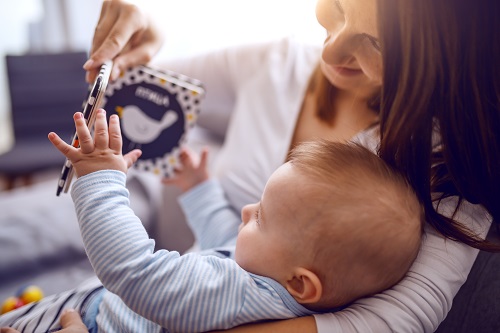Best Budget-Friendly Gifts for Baby
Moms want the best for their babies. The great news is the best toys for babies are also budget-friendly.
While toy trends come and go, moms of all income levels can relax, knowing that best does not equal expensive. The toys your child needs most are timeless. Share on XTen Budget-Friendly Toys For Baby’s First Year:
- Black and white visual stimulation cards – Research shows babies only see the colors black, white, and gray during the first few months after birth. Maximizing proper visual stimulation in those early months ensures your newborn’s eyesight develops well.
- Baby safe mirrors – Babies love faces! Mirror play includes making funny faces, pointing out eyes, ears, and mouths, and creating many laughs. Looking into mirrors helps little ones read facial expressions, pronounce words, and understand feelings. Mirror play is also excellent for teaching eye contact.
- Foam floor mats – Babies need a safe place on the floor to play. From tummy time to toddlerhood, babies need a play area. Foam mats pad the floor and are easy to clean. Look for ones that will last because you’ll find other uses for them when your baby is a toddler.
- Balls – Do not get foam or felt ones for babies because they put everything in their mouths. Offer balls that are easy for the baby to pick up but not small enough to be a choking hazard. Balls are very versatile, as the games babies can create are limitless. They can be picked up, tossed, put into a container, or chased after. A few are enough.
- Pop-up toys – For children who are sitting or crawling, cause-and-effect toys such as pop-up ones allow your child to learn to push buttons, slide switches, and turn knobs. Each of these motor actions requires different muscles and coordination. The pop-up element delights babies and keeps them interested.
- Blocks – Regular blocks are best. Interlocking blocks, such as Duplo® or Lego®, are okay; however, non-interlocking ones require more skill to stack and are better for brain and motor development. Those stamped with letters and pictures offer opportunities for your baby to learn animals, shapes, and colors.
- Shape sorters or puzzles – Select those sorters or puzzles with only a few shapes, such as circles, squares, and triangles. Otherwise, your child may become frustrated and disinterested. Shape sorters and puzzles with big knobs are best for this age. As proven by science, electronic screen-based games for sorting shapes or completing puzzles are inferior to physical versions.
- Climbing toys – Once your baby crawls, they’ll eventually start climbing. Safe climbing toys are ideal so your tot can explore their new physical abilities. Babies need to climb to learn spatial awareness and build strength and coordination. Let them climb so they’re strong and coordinated enough to enjoy playground games with friends when they are older.
- Board books – Offer books with thick cardboard pages and a few pictures. Some babies enjoy listening to a story, but most are too busy. They prefer looking at pictures of things (cups, balls, cars), faces, and animals. Help your baby build a strong vocabulary by naming what you see in the book.
- Push toys – Sturdy push toys are wonderful when your baby is ready to walk. My best budget-friendly suggestion, which babies enjoy, is a 13-gallon plastic storage box with a lid. It makes a great play surface, and your baby will enjoy pushing it around. Plus, it doubles as a toy storage box!
Today’s moms often want tablets with learning apps. However, research consistently proves simple, non-electronic toys, sometimes referred to as traditional toys, are best for your baby’s overall brain and body development. Plus, they’re easier on your wallet.
If you prefer to spend more on your baby, put money aside in their college account. It’s a better investment than toys that entertain more than teach.
What toys are you buying for your baby?


The Conversation
Ginny, I agree with all of your choices. I have also noticed with my grandkids that interacting with them as they play gives them the model they need to play independently. For instance, holding a board book and turning the pages is a beginning stage of reading. Thank you for all of your insights.
Thanks for sharing! When children are on electronic devices, they play alone. However, as they play with physical toys and books, it’s more common to play along with others. Social and emotional delays are so common in today’s young children, and toy selection is a big reason.